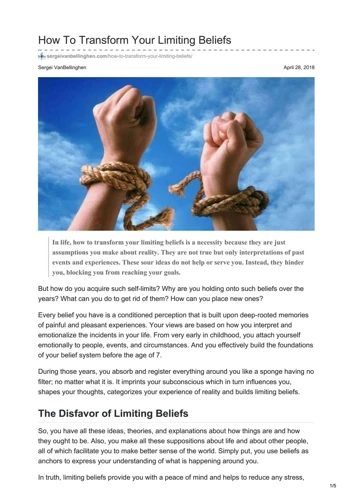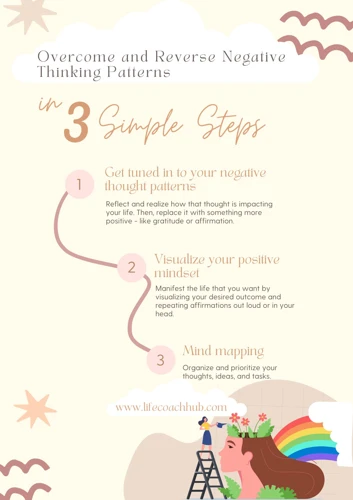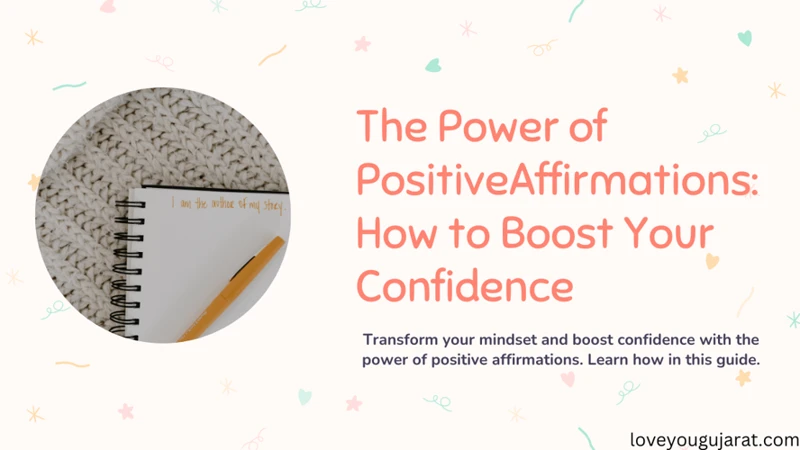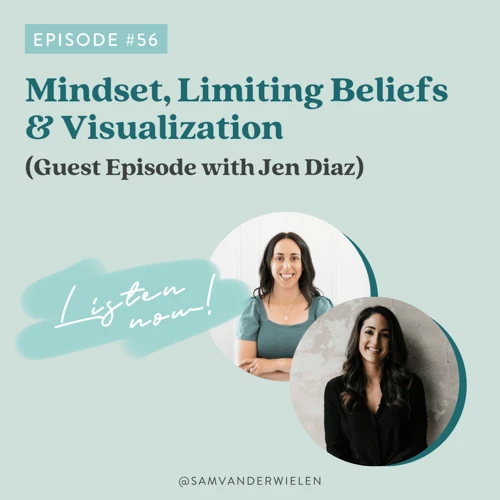The Science of Visualization

Visualizations are a powerful tool for overcoming limiting beliefs and blocks. Studies have shown that the brain does not differentiate between real and imagined experiences. When we visualize ourselves doing something, it activates the same areas of the brain as if we were actually doing it. This means that we can use visualization to create new neural pathways and change our thought patterns.
One of the key benefits of visualization is that it allows us to explore possibilities and test out scenarios in a safe and controlled way. By visualizing different outcomes, we can experiment with different strategies and build our confidence in our ability to handle challenges. This in turn can lead to greater creativity and innovation in all areas of our lives.
Visualization also helps us to focus our attention and energy on our goals. When we have a clear mental image of what we want to achieve, we are more likely to notice opportunities and resources that can help us get there. Additionally, visualization can help us to stay motivated and committed to our goals, especially when facing setbacks or obstacles.
Finally, visualization can have a powerful impact on our emotions and physiology. When we engage our senses in visualization, we create a strong emotional connection to our desired outcome. This can lead to increased feelings of positivity, joy, and gratitude, which in turn can improve our physical health and well-being.
The science of visualization demonstrates that it is a valuable tool for personal growth and transformation. By harnessing its power, we can overcome limiting beliefs and blocks and achieve our goals with greater ease and joy.
Identifying Your Limiting Beliefs and Blocks

Before diving into the process of visualization, it’s important to identify any limiting beliefs and blocks that may be holding you back from realizing your goals. These can be deeply ingrained patterns of thought or behavior that are often subconsciously driving your actions. But by shining a light on them, you can begin to dismantle them and create space for new, empowering beliefs to take hold. Here are some techniques to help you unearth these roadblocks and start breaking them down.
Self-Reflection
Self-reflection is a key component of identifying and overcoming limiting beliefs and blocks. There are several ways to engage in self-reflection, including:
- Observing your thoughts and feelings: Take time to notice the thoughts and emotions that come up throughout your day. Are they positive or negative? Do they reinforce or contradict your goals?
- Examining past experiences: Reflect on experiences in your life that may have contributed to your limiting beliefs or blocks. Consider how those experiences made you feel and how they may continue to affect you.
- Identifying patterns: Look for patterns in your thoughts, feelings, and behaviors. Do you tend to think negatively in certain situations? Do certain people or environments trigger feelings of anxiety or self-doubt?
Self-reflection can be a challenging process as it requires being honest with yourself and acknowledging areas where you may be holding yourself back. However, it can also be incredibly empowering as it allows you to identify areas for growth and change. It may be helpful to journal or talk with a trusted friend or counselor about your self-reflection process.
Journaling
Journaling is a powerful tool for identifying and unpacking your limiting beliefs and blocks. It allows you to get your thoughts and feelings down on paper and explore them in a safe and non-judgmental way. Here are some tips for effective journaling:
- Make it a habit: Set aside a specific time each day to journal. Whether it’s first thing in the morning or right before bed, having a consistent routine will help you stick with it.
- Write freely: Don’t worry about grammar or spelling. Write whatever comes to mind, even if it seems silly or insignificant.
- Ask yourself questions: Use journaling as an opportunity to explore your thoughts and feelings. Ask yourself questions like “What am I afraid of?” or “What is holding me back?” and see where your writing takes you.
- Be honest: Don’t censor yourself or try to sugarcoat your thoughts and feelings. Journaling is a safe space for you to be completely honest with yourself.
- Revisit old entries: Once you’ve been journaling for a while, go back and reread some of your old entries. You may be surprised at what you discover about yourself.
- Use prompts: If you’re not sure where to start, there are plenty of journaling prompts available online. These can help guide your writing and encourage deeper self-reflection.
By regularly journaling, you can gain insight into your subconscious mind and begin to uncover the limiting beliefs and blocks that are holding you back. With this awareness, you’ll be better equipped to begin visualizing your desired outcome and creating a plan to overcome your obstacles.
Working with a Therapist or Spiritual Counselor
Getting professional help from a therapist or spiritual counselor can also be beneficial in identifying and overcoming limiting beliefs and blocks. They have the necessary training and experience to guide you in the right direction and provide you with effective tools and techniques. Here are some ways they can help:
- Objective perspective: A therapist or spiritual counselor can provide an outside perspective on your thought patterns and behaviors. They can help you identify areas where you are getting stuck and offer suggestions for how to move past them.
- Assessment: Through assessments and evaluations, a therapist or spiritual counselor can help you identify any underlying mental health conditions or trauma that may be contributing to your limiting beliefs and blocks.
- Customized treatment plan: Once they have a better understanding of your unique situation, a therapist or spiritual counselor can work with you to create a personalized treatment plan that includes visualization, affirmations, and other tools to help you overcome your limitations.
- Accountability: Working with a professional provides a level of accountability that can be difficult to achieve on your own. They can help you stay motivated and on track as you work to overcome your limiting beliefs and blocks.
- Safe space: Finally, working with a therapist or spiritual counselor provides a safe and supportive space where you can explore your thoughts and emotions without fear of judgment. This can be incredibly empowering and healing.
Remember, there is no shame in seeking professional help to overcome limiting beliefs and blocks. In fact, it is a sign of strength and self-awareness to recognize when you need support and to seek it out.
Visualizing Your Desired Outcome

When it comes to overcoming limiting beliefs and blocks, visualization can be a powerful tool. By creating a mental image of your desired outcome, you can cultivate a sense of clarity and focus that can help you overcome obstacles and move towards success. However, effective visualization requires more than simply imagining a vague image in your mind. In this section, we will explore the science of visualization, the importance of creating a clear mental image, and how to engage your senses to make your visualization more vivid and impactful.
Creating a Clear Mental Image
When it comes to visualizing a desired outcome, it’s important to create a clear mental image that you can focus on during your visualization practice. This helps to bring your desired outcome to life in your mind, making it feel more tangible and achievable. To create a clear mental image, consider the following:
| 1. Be specific: | When visualizing, it’s important to be specific about what you want to achieve. For example, rather than visualizing “success,” visualize a specific accomplishment, like landing a new job or graduating from school. |
| 2. Use vivid details: | In your visualization, try to engage as many senses as possible. What does it look, feel, and smell like to achieve your desired outcome? The more vivid the details, the more real your mental image will feel. |
| 3. Focus on the positive: | Avoid visualizing potential obstacles or challenges. Instead, focus solely on the positive outcome you want to achieve. This helps to keep your visualization practice motivating and uplifting. |
| 4. Repeat your visualization: | The more you visualize your desired outcome, the clearer and more detailed your mental image will become. Repeat your visualization practice daily, and consider setting aside dedicated time for this practice. |
By following these tips and creating a clear mental image of your desired outcome, you can enhance the power of your visualization practice and bring yourself closer to achieving your goals.
Engaging Your Senses
When visualizing your desired outcome, engaging your senses can make your mental image more vivid and realistic, thereby increasing the effectiveness of your visualization technique. Here are some ways to incorporate your senses into your visualization practice:
- Sight: Imagine yourself in a specific setting, and visualize the colors, shapes, and details of your surroundings. If you’re visualizing a goal such as a new house or car, picture every aspect of it in your mind, from the exterior design to the interior decorations.
- Hearing: Imagine sounds that would accompany your desired outcome. For instance, if you’re visualizing success in a particular career or project, imagine the cheering of coworkers, the applause of an audience, or the sound of a cash register ringing as a sale is made.
- Touch: Envision how your desired outcome would feel. If it’s a physical object, imagine the texture and weight of it in your hand. If it’s an experience, imagine the emotions that would accompany it, such as joy, excitement, or accomplishment.
- Smell: If your desired outcome has a particular aroma associated with it, imagine that smell. For example, if you’re visualizing a beach vacation, imagine the scent of salty air and sunscreen.
- Taste: If your desired outcome involves food or drink, imagine the taste of it. Savor the flavors and textures in your mind, whether it’s a favorite meal or a celebratory champagne toast.
Engaging all of your senses when visualizing can make the experience more immersive and impactful. The more detail and specificity you can bring to your mental image, the more real it will feel to your brain, increasing your motivation and belief in your ability to achieve your desired outcome.
Practicing Daily Visualization
One key aspect of using visualization to overcome limiting beliefs and blocks is the practice of daily visualization. This involves setting aside time each day to engage in visualization exercises that help you to vividly see and feel your desired outcome.
Benefits of Daily Visualization
Regular visualization practice can help to rewire your brain and shift your subconscious beliefs, making it easier to reach your goals. By consistently focusing on your desired outcome and seeing yourself already living that reality, you begin to attract the people and resources needed to make it a reality. This creates a positive feedback loop that reinforces your motivation and confidence.
How to Practice Daily Visualization
To make the most of your daily visualization practice, follow these steps:
| Step | Description |
|---|---|
| Step 1 | Find a quiet, comfortable space where you won’t be disturbed. This could be a dedicated meditation area, or simply a quiet room in your home. |
| Step 2 | Get into a relaxed state by taking a few deep breaths and releasing any tension in your body. You may want to do some light stretching or yoga beforehand to help you get into this state. |
| Step 3 | Begin to visualize your desired outcome in as much detail as possible. See yourself already living that reality, and engage your senses to make the visualization as vivid as possible. |
| Step 4 | Stay in this visualization for at least 5-10 minutes, or longer if you have the time. |
| Step 5 | When you’re finished, take a few deep breaths and come back to the present moment. You may want to journal about any insights or emotions that came up during the visualization. |
Tips for Success
To make your daily visualization practice more effective, try these tips:
- Be consistent: Try to practice visualization at the same time each day, such as first thing in the morning or before bed. This helps to create a habit and makes it easier to stick with.
- Keep it positive: Focus on the positive aspects of your desired outcome, rather than any potential obstacles or challenges.
- Mix it up: Try different visualization exercises, such as imagining yourself giving a successful presentation or nailing a difficult yoga pose.
- Stay open: Allow your visualization practice to evolve and adapt as needed. You may find that your goals or desires change over time, and your visualization practice should reflect that.
By incorporating daily visualization into your routine and following these tips, you’ll be on your way to overcoming limiting beliefs and achieving your goals.
Using Positive Affirmations to Reinforce Your Visualization

As you work on visualizing your desired outcome and taking steps to overcome limiting beliefs and blocks, you may also benefit from incorporating positive affirmations into your daily routine. Positive affirmations can help to reinforce the mental image you’re creating through visualization and shift your mindset towards a more positive, empowered perspective. In this section, we’ll explore the science behind positive affirmations and offer tips for incorporating them into your daily practice.
Choosing the Right Words
When it comes to using positive affirmations, choosing the right words is essential. Your affirmations should be specific, positive, and relevant to the limiting belief or block that you are trying to overcome. Here are some tips for choosing the right words for your affirmations:
| Tip | Explanation |
|---|---|
| Focus on the Positive | Your affirmations should be framed in a positive way. Rather than saying, “I am not afraid of public speaking,” say, “I am confident and comfortable when I speak in front of others.” |
| Be Specific | Your affirmations should be specific to the limiting belief or block that you are trying to overcome. If your limiting belief is that you are not good enough, your affirmation could be, “I am enough just as I am.” |
| Use Strong Language | Use strong and empowering language in your affirmations. Words like “powerful,” “capable,” and “confident” can help to reinforce the positive message. |
| Make it Personal | Use the first person when creating your affirmations. Saying “I am” or “I can” reinforces your personal power and sets a clear intention for yourself. |
| Keep it Present Tense | Your affirmations should be in present tense. This helps to program your mind and body to believe that what you want is already happening. |
| Avoid Negative Words | Avoid using negative words like “don’t,” “can’t,” and “won’t” in your affirmations. These words can actually reinforce the negative belief or block that you are trying to overcome. |
| Be Realistic | It’s important to be realistic when creating your affirmations. If your limiting belief is that you can’t fly, it’s probably not the best idea to create an affirmation that says, “I am flying every day.” |
Remember that your affirmations should resonate with you personally. Take some time to experiment with different wording and see what feels most powerful and effective for you. The more you reinforce positive messages to yourself, the easier it will be to overcome limiting beliefs and blocks.
Repeating Your Affirmations Regularly
One important aspect of using positive affirmations to reinforce your visualization is repetition. It is essential to repeat your affirmations regularly to keep them at the forefront of your mind and to strengthen your belief in them. Here are some tips for incorporating repetition into your affirmation practice:
- Set a daily reminder: Whether it’s a notification on your phone or a sticky note on your fridge, setting a reminder can help you remember to repeat your affirmations daily.
- Create a routine: Incorporate your affirmation repetition into your daily routine, such as repeating them while getting ready in the morning or during your daily meditation practice.
- Use repetition techniques: There are several techniques you can use to repeat your affirmations, such as visualization, writing them down repeatedly, or saying them out loud multiple times.
- Make it a habit: Repetition is most effective when it becomes a habit. Consistently repeating your affirmations can help make them a natural part of your thought process.
- Vary the delivery: Experiment with different ways of delivering your affirmations, such as saying them with different tones or emphasizing different words. This can help keep your affirmation practice fresh and engaging.
Remember that repetition is key to reinforcing your positive affirmations and strengthening your belief in your ability to overcome your limiting beliefs and achieve your goals. Find a repetition technique that works for you and make it a daily habit to maximize the benefits of affirmation practice.
Believing in Your Affirmations
Believing in your affirmations is a crucial component of using visualization to overcome limiting beliefs and blocks. Without belief in the power of your affirmations, it can be difficult to make progress towards your desired outcome. Below are some strategies for cultivating belief in your affirmations:
| Strategy | Description |
|---|---|
| Start small | Begin with affirmations that feel achievable and realistic. It can be challenging to believe in affirmations that feel too far-fetched or unlikely. |
| Repeat affirmations often | The more frequently you repeat your affirmations, the more likely you are to start believing in them. Make a habit of repeating your affirmations daily, ideally multiple times a day. |
| Use emotion in your affirmations | Affirmations that evoke strong positive feelings are more likely to be believed. Tap into your emotions as you create and repeat your affirmations. |
| Affirm what you already believe | Start with affirmations that align with your current beliefs. As you gain confidence and belief in those affirmations, you can gradually expand and challenge your beliefs with new affirmations. |
| Avoid resistance | If you come across resistance towards an affirmation, it may be too far outside of your current mindset. Adjust the affirmation to be more easily accepted or create a steppingstone affirmation that bridges the gap to the more challenging affirmation. |
By utilizing these strategies, you can begin to cultivate a strong belief in your affirmations and ultimately see progress towards your desired outcomes. Remember that belief is a process and may take time to fully develop. Be patient with yourself and continue to practice regularly.
Overcoming Obstacles and Challenges
Even with a clear visualization and positive affirmations, obstacles and challenges may arise on your journey to overcoming limiting beliefs and blocks. It’s important to cultivate persistence and resilience in order to push through these obstacles. It’s also helpful to seek support and encouragement from those around you. Finally, adjusting your visualization and affirmations as needed can help you stay aligned with your desired outcome. Let’s explore each of these strategies in more detail.
Cultivating Persistence and Resilience
Cultivating persistence and resilience is an essential aspect of using visualization to overcome limiting beliefs and blocks. Here are some strategies that can help you stay focused and committed to your goals:
- Break your goal down into smaller steps: When you feel overwhelmed, it’s easy to lose motivation and give up. One way to avoid this is to break your main goal into smaller, more manageable steps that you can work on one at a time. This will help you build momentum and stay motivated as you make progress towards your ultimate objective.
- Focus on the process: It’s easy to get fixated on the end result and forget about the journey towards it. However, if you want to cultivate persistence and resilience, it’s important to focus on the process as well. Enjoying the process can make it easier to stay motivated, overcome obstacles, and appreciate the growth that you experience along the way.
- Keep a positive attitude: Cultivating a positive mindset can help you stay motivated and overcome challenges more easily. This doesn’t mean ignoring problems or never acknowledging negative emotions, but rather focusing on the good and finding ways to reframe challenging situations in a more positive light.
- Practice self-care: Taking care of your physical, emotional, and mental health is key to cultivating persistence and resilience. This can include things like getting enough sleep, eating a healthy diet, exercising regularly, and engaging in activities that bring you joy and relaxation.
- Learn from setbacks: Everyone experiences setbacks and failures on the path towards their goals. Rather than letting these hold you back, use them as opportunities to learn and grow. Reflect on what went wrong, what you could have done differently, and how you can improve in the future.
- Stay accountable: Having someone to hold you accountable can be incredibly helpful when trying to cultivate persistence and resilience. This can be a friend, family member, therapist, or coach who can provide support, guidance, and motivation when you need it most.
By practicing these strategies, you can cultivate the persistence and resilience that will help you overcome limiting beliefs and blocks and achieve your goals. Remember that everyone faces obstacles and challenges, but with the right mindset and support, you can overcome them and make progress towards the life you desire.
Finding Support and Encouragement
One of the key factors in overcoming obstacles and challenges when using visualization and positive affirmations is finding support and encouragement. Here are a few ways to find that support:
- Join a Support Group: You can find support from others who are going through similar challenges by joining a support group. This can be an online group or an in-person group depending on your preference. By sharing your experiences and listening to others, you can gain valuable insights and encouragement.
- Work with a Coach: A coach can help you identify your limiting beliefs and blocks and provide you with tailored guidance and support to help you overcome them. A coach can also keep you accountable and help you stay on track with your visualization and affirmations.
- Surround Yourself with Positive People: It’s important to surround yourself with people who are positive and supportive. They can provide you with the encouragement and motivation you need to stay committed to your goals.
Remember, it’s not always easy to overcome limiting beliefs and blocks, but with the right support and encouragement, you can achieve your goals and live the life you desire.
Adjusting Your Visualization and Affirmations as Needed
As you work on visualizing your desired outcome and using positive affirmations to reinforce this vision, it’s important to remember that life is constantly changing and evolving. This means that your goals, desires, and even your limiting beliefs and blocks may shift over time. For this reason, it’s crucial to keep an open mind and be willing to adjust your visualization and affirmations as needed.
Here are some steps you can take to adjust your visualization and affirmations:
- Stay open-minded: As you move through different phases of your life, your desires and goals may change. Make sure to stay open to new opportunities and experiences that may come your way.
- Regularly reassess your goals and desires: Take time to reflect on your current goals and desires. Are they still in line with what you truly want? If not, it’s important to make adjustments so that you’re working towards something that truly ignites passion within you.
- Revise your affirmations: If you find that certain affirmations are no longer resonating with you, don’t be afraid to revise them. Remember to choose words that feel empowering and uplifting to you.
- Update your visualization: Your mental image of your desired outcome may change over time. Don’t be afraid to adjust and refine this image as you go. Just make sure that it still feels inspiring and motivating to you.
- Take note of changes in your limiting beliefs and blocks: As you work on overcoming your limiting beliefs and blocks, you may find that they shift or transform in unexpected ways. Be mindful of these changes, and adjust your visualization and affirmations accordingly.
Remember, the key to success when using visualization and affirmations is to stay flexible and willing to adjust as needed. By doing so, you’ll be better able to stay aligned with your goals and desires, and overcome any obstacles that may come your way.
Conclusion
In conclusion, using visualization techniques to overcome limiting beliefs and blocks can be an incredibly powerful tool for personal growth and transformation. Through the process of self-reflection, identifying your limiting beliefs and blocks, creating clear mental images of your desired outcome, and using positive affirmations to reinforce your visualization, you can begin to shift your perspective and transform your reality.
It is important to note that overcoming obstacles and challenges in life is not always easy, and may require persistence, resilience, and support from others. It is also important to adjust your visualization and affirmations as needed to ensure they remain aligned with your current goals and desires.
Overall, by incorporating visualization and positive affirmations into your daily routine, you can cultivate a more optimistic and confident mindset, and begin to unlock your full potential. Remember to believe in yourself, stay focused on your goals, and use visualization as a powerful tool to create the life you truly desire.
Frequently Asked Questions
How long does it take for visualization to work?
It varies for each person, but with consistent practice, results can start to manifest within a few weeks to a few months.
Can visualization alone eliminate all my limiting beliefs and blocks?
No, visualization is a powerful tool, but it should be used in combination with other strategies like therapy, self-reflection, and positive affirmations for optimal results.
Do I need to be spiritual to benefit from visualization?
No, visualization is a technique that can be used by anyone, regardless of their beliefs or spirituality.
Is there a right or wrong way to visualize?
There is no right or wrong way to visualize as long as you create a clear mental image and engage your senses to make the experience as vivid as possible.
Are positive affirmations effective for everyone?
Although positive affirmations can be helpful for many people, they may not be effective for everyone. It depends on the individual and their receptivity to the practice.
Can visualization make me forget about my problems?
No, visualization is not a way to ignore or suppress problems. Instead, it helps individuals see their problems in a new light, which can lead to finding more effective solutions.
Should I visualize my desired outcome once or multiple times?
It is recommended to practice visualization daily, ideally multiple times a day, to reinforce the mental image and keep it at the forefront of your mind.
Can visualization be used in combination with medication?
Yes, visualization can be used in conjunction with medication or other treatments. It is always best to consult with a healthcare professional before making any changes to treatment plans.
What should I do if I’m not seeing any results from visualization?
It could be helpful to try adjusting your technique, seeking additional support, or exploring other strategies like therapy or self-reflection. It’s important to have patience and persistence in the process.
Can visualization help with physical health issues?
While visualization should not replace medical treatment, it can be used as a complementary strategy to promote relaxation, reduce stress, and potentially improve overall health and well-being.








